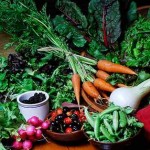 What foods provide vitamin K?
What foods provide vitamin K?
This post is a follow up on a recently published article called Is that Newborn Vitamin K Shot really necessary?.
Excellent sources of vitamin K include parsley, kale, spinach, Brussels sprouts, Swiss chard, green beans, asparagus, broccoli, kale, mustard greens, turnip greens, collard greens, thyme, romaine lettuce, sage, oregano, cabbage, celery, sea vegetables, cucumber, leeks, cauliflower, tomatoes, and blueberries.
Fermentation of foods can be especially helpful for increasing their vitamin K content. One widely-enjoyed food that can be fermented in a way that increases its vitamin K content is cheese. Swiss Emmental cheese and Norwegian Jarlsberg cheeses are examples of cheeses fermented by bacteria called Proprionibacterium. These bacteria can make large amounts of vitamin K in the form of menaquinone 9(H4), or MK-9(H4). (MK-9(H4), like all menaquinones, is a K2 form of the vitamin.)
Within this general category of fermented foods and vitamin K, a very special place must be given to fermented soy foods. Bacillus subtilis is not the most famous micro-organism used in fermentation of soybeans. (That distinction goes to the koji mold, Aspergillus oryzae, that is used in fermentation of many soy pastes, as well as soy miso and soy sauce. But in the context of vitamin K benefits, Bacillus bacteria may be the most important micro-organisms used in soybean fermentation based on their ability to create a K2 form of the vitamin called menaquinone-7 (MK-7). Studies have shown that higher levels of MK-7 in the blood correspond to lower risk of hip fracture in older Japanese women, and that higher MK-7 levels also correspond to increased intake of soy foods fermented with Bacillus bacteria.
One fascinating aspect of Bacillus-fermented soy foods is the potential ability of these bacteria to stay alive in our lower intestine after these foods are consumed and continue providing us with vitamin K2 (in the form of MK-7). We’ve seen one study in which 1.6-20 million Bacillus bacteria (per gram of feces) were found to remain alive up to 6 days following consumption of natto.
As is true in Japanese diets, fermented soy foods are the most common source of MK-7 in the U.S. diet. Meats and eggs are our most common food sources of the menaquinone MK-4 (another form of vitamin K2). (Remember that all forms of vitamin K including K2 menaquinones like MK-4 and MK-7 and also K1 phylloquinones make great contributions to our health!)
Many forms of lettuce contain worthwhile amounts of vitamin K. It is worth noting here that on an ounce-per-ounce basis, romaine lettuce may be about four times higher in vitamin K than iceberg lettuce according to studies conducted at the U.S. Department of Agriculture.
Since vitamin K is a fat-soluble family of nutrients, foods tend to become higher in vitamin K as they become less concentrated with water. For example, on an ounce-for-ounce basis, tomato paste is higher in vitamin K than fresh tomatoes.
Sometimes the outer leaves of a plant can be more concentrated in vitamin K than the inner leaves. We’ve seen research documenting this difference for both cabbage and Brussels sprouts. For this reason, it may be worthwhile to very carefully and gently scrub these vegetables with a natural bristle brush while rinsing them under a flow of clean water as a way to clean the other leaves and keep them included in your meal rather than simply discarding these outside leaves due to presence of dirt or other particles.
